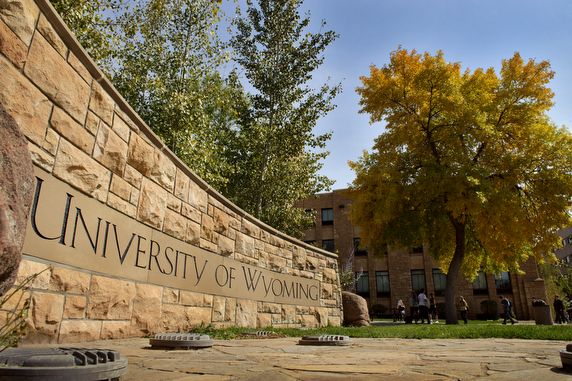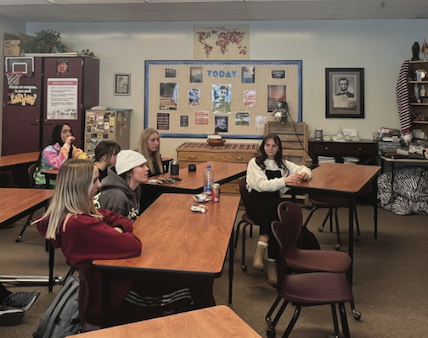◆ Trustees finalize $16. 5 million in cuts. Additional cuts coming associated with a reduction in Legislature’s block grant.
By Daniel Bendtsen
WyoFile.com/WNE
The University of Wyoming will enter the 2022 fiscal year with a wide array of new financial constraints after the school’s board of trustees finalized roughly $16.5 million in reduced spending on June 16.
Deans and other university leaders have warned that the cuts will further strain the overworked faculty and will hinder the academic ambitions established by administrators and the Wyoming Legislature.
And yet the worst is still to come; next month UW leaders plan to announce up to $17.5 million in additional cuts. Those are expected to result in a pronounced constriction of UW’s programming.
The budget woes are largely the consequence of a $31.3 million cut to UW’s block grant approved by the Legislature this spring as part of a broader effort to offset diminishing revenues from Wyoming’s minerals industry. During UW budget hearings in May, most deans expressed concern about faculty shortages — a persistent issue since the last round of budget cuts in 2016 — and President Ed Seidel warned the upcoming academic year is likely to be “a bit more turbulent” for faculty losses.
The College of Education will take a 10% cut under the new budget, losing four faculty slots and 60 credit hours worth of teaching.
The college’s interim dean, Leslie Rush, told trustees that the college has “unsustainable shortages” in certain programs, most notably early education and the college’s leadership program, the latter of which now only has one full-time faculty member.
“People are stretched pretty thin and this is going to stretch them further,” she said. “What we’re experiencing throughout our programs is an increased reliance on adjunct faculty to deliver required curriculum.”
The College of Business is losing six faculty positions, which accounts for more than 10% of that college’s total faculty.
“Sometimes there’s a narrative in the state that there have not been costs at the university and that maybe we’ve not had personnel reductions,” College of Business interim dean Rob Godby said last month.
“Sometimes people don’t realize what types of personnel reductions that have gone on because they haven’t come through a huge [reduction in force], but because they’ve been through attrition.”
The cuts mean the college’s remaining faculty no longer have the capacity to teach all required classes for the College of Business’s majors and minors, Godby said. To get students to graduation on time, the college will grant waivers for students, allowing them to complete different courses to finish their degrees.
“It’s not optimal because you obviously design a major and minor to cover specific subject areas,” he said.
The high teaching load of College of Business professors also means it will only be harder to recruit new faculty, who expect to be able to dedicate more of their time to research, Godby said.
“That’s been one of the reasons in particular that we’ve had trouble keeping faculty in finance, because they can have lower teaching loads at a research institution,” he said. Godby said the college is now relying more on online classes, which isn’t ideal for on-campus students.
“I don’t find it an acceptable solution that a student in economics may not be able to get into a face-to-face class before their fourth year, but that is an example of what the immediate effects of these cuts have been,” he said.
The budget reductions are also undermining major investments for STEM programming the Legislature has made in the past decade.
From 2012-2014, the Legislature and former Gov. Matt Mead worked to craft a plan to bring the College of Engineering and Applied Sciences up to “Tier 1” status, a somewhat loose label that independent observers bestow upon the country’s top engineering schools like MIT and Stanford. In 2014, the Legislature approved $26.4 million in initial funding for UW to work toward that goal. The Legislature later funded construction of the $105 million Engineering Education and Research Building, which opened in 2019.
Despite those mammoth investments, that funding was appropriated on a one-time basis, and the College of Engineering continues to face general fund reductions, making it difficult to maintain the sustainable long-term investment needed to bring the college to Tier 1 status. Both the 2016 cuts and the new round in the 2022 fiscal year budget have scaled back funding for professors and PhD students, meaning the College of Engineering is no closer to reaching its Tier 1 aspiration than it was five years ago, according to interim dean Cameron Wright. With the new cuts, it’s “extremely difficult” for the college to achieve that goal, he said.
The college lost faculty after UW’s biennial budget was cut by $42 million in 2016, and it is losing another eight faculty positions as a result of the latest budget cuts.
“The gains we’ve made towards Tier 1 status are in jeopardy. We have insufficient faculty numbers and it’s certainly affecting the educational experience of our students as well as their career preparations,” Wright said. “We’re to the point now that faculty sizes are so small in all departments that required courses are taught once a year, and so when a student [doesn’t complete a class], it puts them back a year. It’s a time-to-degree issue. It’s a student morale issue and, to some degree, it affects instructor proficiency because they aren’t teaching those classes that often.”
As with the College of Education, the engineering college is now only able to deliver an accredited program by relying on temporary lecturers. Wright said he now has to hire — each semester — 20-30 temporary lecturers, who are incapable of bringing in new research grants or serving in significant mentorship roles for students in the way faculty do.
“None of that happens with temporary lecturers, so when I’m hiring 20-30 of them each semester, I feel like I’m just throwing money away,” he said.
When the first round of Tier 1 funding came in, the College of Engineering increased its number of PhD students and invested in collaborative lab projects, but such efforts are no longer possible, Wright said.
During budget hearings, UW Trustee and former Speaker of the House Kermit Brown said the withering of Tier 1 goals is particularly concerning.
“From my years in the Legislature, I’m perhaps more sensitive than some about how important that was viewed in the Legislature and continues to be viewed,” he said. The Legislature appropriated $3 million for the Tier 1 goal in 2019 and, at the behest of former Senate President Eli Bebout, allocated another $1 million in 2020.
Wright said his one current hope to reverse the loss of faculty is to develop an increased reliance on “soft money,” like federal grants or American Recovery Plan Act funding that could be used to set up self-sustaining programs.
The latest budget cuts are also hammering the College of Agriculture and Natural Resources, whose decline in programming after the 2016 cuts has been a particular concern for legislators on the Agriculture, State and Public Lands & Water Resources Committee.
During the 2016 budget cuts, many employees in the College of Agriculture took advantage of early retirement incentives. The college lost 15% of its staffing in that cut and has yet to reverse those losses. The college is also no longer competitive for grants and contracts because the condition of current facilities is “not up to modern standards for agricultural research,” Dean Barbara Rasco said in May.
During an August inspection of UW’s animal facilities — in which UW houses about 100 sheep and another 100 other animals — the U.S. Department of Agriculture reported that one shelter for sheep had broken sides that left the sheep vulnerable to “jagged edges and wires.” The USDA also reported that inadequate maintenance exposed sheep to dirty water and a chipmunk facility had overgrown vegetation — both scenarios put the animals at risk for disease, the report states.
Rasco fears she’ll lose even more faculty members in the upcoming year.
“One of the biggest challenges we have in our college is loss of talent due to increased competition from other institutions and the private sector, as well as salary inversion and compression within our college,” Rasco told the trustees. “We’re finding that we’re in a global market now for people in our college who have been asked to take positions with NGOs and government entities and will still be able to be housed in Laramie. The whole focus in our job market has shifted and we’re very much concerned that, with COVID and the shift to online work, that there’s going to be greater risk of having our faculty poached now more than ever.”
The budget cuts threaten the college’s ability to meet federal cost-share requirements for research grants, she said.
“If we face another cut of this size, we are going to be in a position where we are going to forfeit federal dollars because we can’t make the match requirements,” she said.
Losing staff is also a major concern for athletic director Tom Burman, who instituted pay cuts of 2.5-5% for his staff.
“We have some very talented people in our department, and when you ask them to take a 5% pay cut — we’re going to have to address that pretty soon or we’re going to have some pretty fast defections,” he told trustees.
UW’s financial picture is also undermining plans for another major project: the $100 million Science Initiative building, which is set to open this fall. While many units have made plans to move faculty into the space, there’s still no identified funds to complete a 5,000-square-foot lab on the building’s fourth floor, said Greg Brown, associate dean for the College of Arts and Sciences who’s overseen the Science Initiative’s development.
Because of a lack of funding, Brown said plans are also “on thin ice” for the Center for Advanced Scientific Instrumentation, a planned wing of the Science Initiative building that would provide state-of-the-art equipment like spectrometers and microscopes for faculty across campus and community colleges.
Meanwhile, administrators are preparing a plan, set to be unveiled by July 15, to cut expenditures from the state’s general fund by another 10% — roughly $17.5 million. To prepare for that cut, a group of faculty and students were tasked last fall with conducting a “strategic portfolio review,” in which all academic programs were ranked based on factors like UW’s strategic plan, the needs of the state and student demand.
Those findings, which have not been made public, were submitted to the Office of Academic Affairs in late April. Within the next month, UW is scheduled to publish a report that proposes consolidation, reorganization and elimination of some programs.
“We will do the very best we can at preserving everything we can that we think is important to the state while finding ways to reduce our expenditures, because the state budget cuts have made that imperative,” Seidel said, noting there would be “very difficult decisions expected in July.”
To compensate for the state’s bleak financial picture, Seidel said UW needs to diversify revenue sources — especially by seeking more federal funding. To compete against China, the U.S. Senate passed the U.S. Innovation and Competition Act earlier this month. If it becomes law, the bill would add $81 billion to the National Science Foundation over the next five years — doubling the agency’s budget.
Seidel said he’s met with NSF’s director to ensure UW is prepared to compete for the expected funding.
“I want to make sure we’re in a very good position to receive some of those funds,” he said. “It’s the kind of thing the university hasn’t been real active in during the past — working the federal channels of funding.”
Some revenue losses will also be offset by the $18.6 million UW is set to receive in the upcoming year from the American Recovery Plan Act, though at least half that sum is required to be spent on direct aid to students.
UW will also compete for the $1.1 billion in ARP funding that Gov. Mark Gordon and the Legislature are in charge of doling out in coming years.






